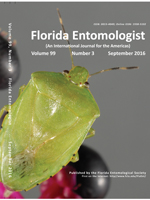Prolonged emergence of Trachykele blondeli blondeli Marseul (Coleoptera: Buprestidae) is reported from kiln-dried and subsequently painted wood in this report. The specimen emergence is a new record for Florida. Because the specimen did not emerge from host plant material grown in Florida, it is likely that its origin was exterior to Florida. Because of delayed and prolonged emergence capability in Buprestidae, as well as specimen survival of wood preservation processes like kiln drying, the current report does indicate a concern for redistribution of non-indigenous buprestid species to new areas.
Delayed and prolonged emergence of Buprestidae occurs in several genera. Huguenin (1915) was the first to report the phenomenon of delayed emergence of Buprestis (Cypriacis) aurulenta L. (Coleoptera: Buprestidae), emerging after 26 yr from a door sill that had been varnished and painted twice. Smith (1962) reported 32 instances of B. aurulenta emerging after 26 yr and the longest of 51 yr, setting a new record for the longest insect life cycle.
On 1 Mar 2015, C. E. Herzog witnessed a buprestid emerging from a door frame of a house in Sarasota, Florida. She photographed the emerging adult and placed the images on BugGuide (Herzog 2015) for identification. A tentative identification of Trachykele blondeli Marseul (Coleoptera: Buprestidae) was made by Vassili Belov. The specimen identification was subsequently confirmed by the first author as Trachykele blondeli blondeli Marseul (Coleoptera: Buprestidae), the western cedar borer. The specimen emerged from a 2.5 × 10 × 20 cm kiln-dried cedar board purchased at a Sarasota, Florida, lumber supply store during Mar 2013 and subsequently installed and painted shortly afterward. The specimen collection data is FLORIDA, Sarasota Co., Sarasota, 1-III-2015, C. Herzog. The specimen currently is housed in TSRS (Evenhuis & Samuelson 2007). The report is the first known collection of T. blondeli blondeli in Florida. The western cedar borer is endemic from British Columbia south to Arizona, New Mexico, and Mexico (Nelson et al. 2008).
The initial genus and species description of western cedar borer was based on a single specimen found at a customs warehouse in Paris, France (Marseul 1865). The first host record description was described as “. . . sortant d'un cédre du Liban” or out of a cedar of Lebanon (Cedrus libani A. Rich.; Pinales: Pinaceae), and the type locality was deemed to be Liban (i.e., Lebanon) (Marseul 1865). Burke (1928) stated that the wood's origin was never accurately determined, but must be from an unknown North American cedar species (Pinales: Cupressaceae), because all other known collections of T. blondeli blondeli are from [western] North America. Eight species and subspecies of Trachykele are known to occur in the United States. Seven Trachykele species utilize hosts in the family Cupressaceae, whereas the 8th, Trachykele nimbosa Fall (Coleoptera: Buprestidae), uses Abies spp. (Pinales: Pinaceae) and Tsuga mertensiana (Bong.) Carrière (Pinales: Pinaceae) (Nelson et al. 2008).
This report highlights the potential for Buprestidae to remain undetected in lumber products and to be redistributed to new areas. The report also provides evidence for T. blondeli blondeli survival during the lumber kiln-drying process, but it is unknown whether the specimen was in the larval, pupal, or adult stage during kiln drying.
We thank Nadeer Youssef for his input on this report and Ted Mac-Rae, Hans Mühle, Mark Volkovitsh, and Rick Westcott for their assistance with finding the original description of T. blondeli Marseul and for constructive comments to improve the manuscript.





